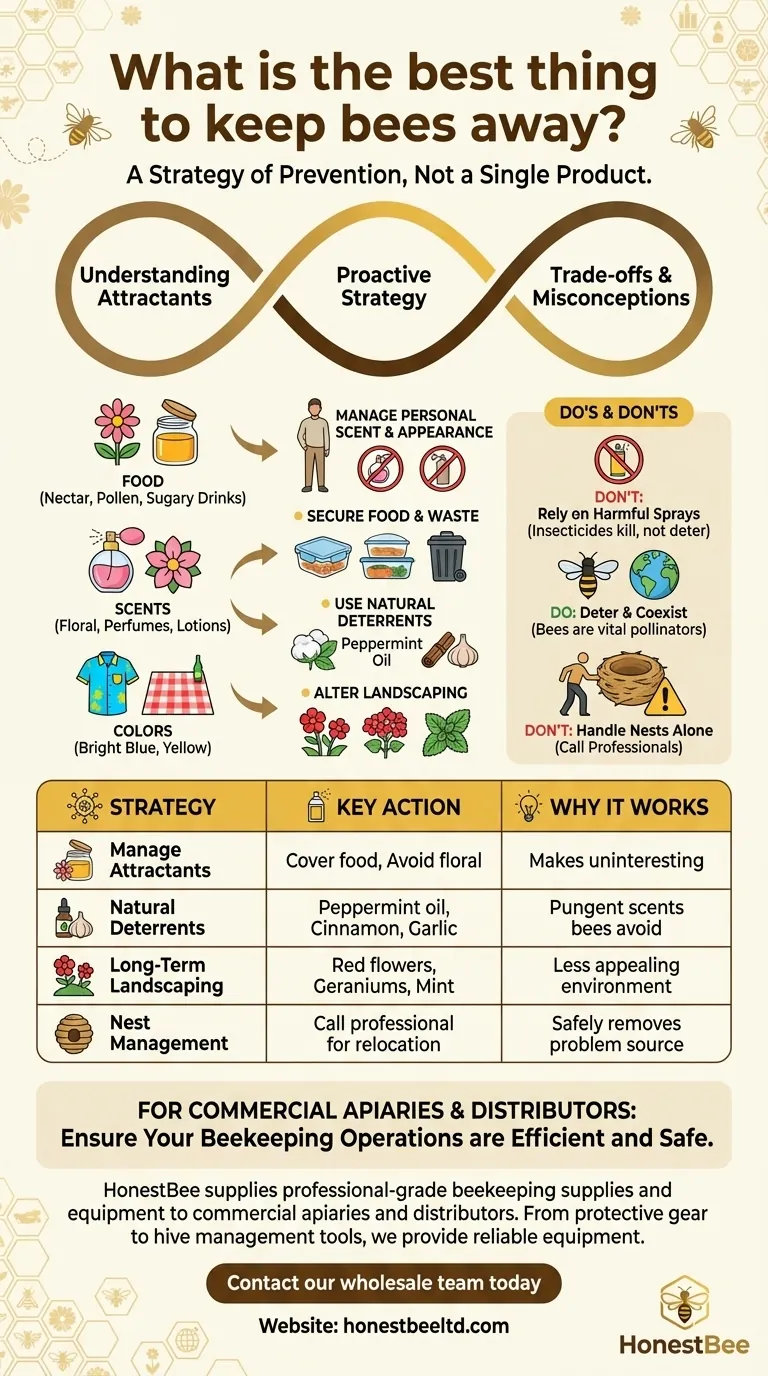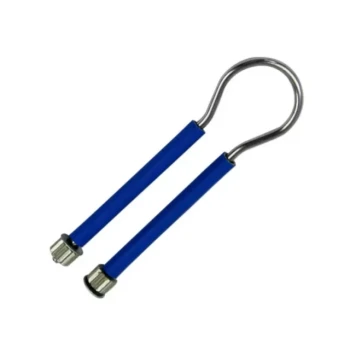The most effective way to keep bees away is not a single product or spray, but a strategy of prevention. The best approach involves systematically removing the things that attract bees to your area in the first place, such as specific scents, colors, and uncovered food sources.
The core principle of keeping bees away is to make your environment uninteresting and unattractive to them. Rather than relying on a single repellent, a combination of proactive steps to manage scents, food, and landscaping is the most reliable and responsible method.

Understanding What Attracts Bees
Before you can deter bees, you must understand what they are looking for. A bee that is away from its hive is almost always searching for resources, not for trouble.
The Search for Food
Bees are driven by an instinct to find nectar (sugar) for energy and pollen (protein) for their young. Sugary drinks, open food containers, and even the sweet scent of fruit on the vine are powerful attractants.
The Lure of Scents
Bees have a highly developed sense of smell. They are naturally drawn to the floral scents of flowers, but they can easily mistake perfumes, scented lotions, and fragrant hair products for a potential food source.
Mistaken Identity
Bees do not see the world as we do. Bright colors, particularly blues and yellows, can resemble the vibrant flowers they seek for pollen and nectar. A brightly colored shirt or picnic blanket can inadvertently invite them to investigate.
A Proactive Strategy for a Bee-Free Zone
Creating an area that bees will naturally avoid involves a few simple, strategic adjustments to your environment and personal habits.
Manage Your Personal Scent and Appearance
Your first line of defense is to make yourself personally uninteresting to a foraging bee. Avoid wearing floral perfumes, colognes, or heavily scented lotions when you plan to be outdoors for extended periods.
Opt for neutral-colored clothing, like whites, tans, and grays, instead of bright floral patterns.
Secure Food and Waste Sources
During picnics or outdoor dining, keep all food and drinks securely covered. Use containers with tight-fitting lids and consider drink dispensers with spigots instead of open pitchers.
Clean up spills immediately and ensure garbage cans are sealed and located away from your main activity area.
Use Scents Bees Dislike
While bees are attracted to sweet smells, they are deterred by certain strong, pungent scents. Placing cotton balls soaked in peppermint oil, or spreading ground cinnamon or garlic powder around your seating area can act as a natural, localized repellent.
Alter Your Landscaping
If bees are a persistent issue in your yard, consider your landscaping. Bees are less attracted to plants with red flowers, as they often can't see the color red. Plants like geraniums and mint are also known to be less appealing to them.
Understanding the Trade-offs and Misconceptions
Many common beliefs about repelling bees are ineffective or needlessly harmful. A clear understanding helps you make better decisions.
The Ineffectiveness of "Repellent" Sprays
Most commercially available "bee repellent" sprays are actually insecticides. These products are designed to kill, not deter. Using them on a foraging bee is both unnecessary and harmful to crucial pollinators. True repellents, based on scents, are a much better and safer choice.
The Importance of Not Harming Bees
A single bee on your patio is not a threat; it's a vital part of our ecosystem. These pollinators are responsible for a significant portion of the food we eat. The goal should always be to deter and coexist, not to kill.
A Passing Bee vs. a Nearby Nest
It's critical to distinguish between a lone foraging bee and a swarm of defensive bees. If you see just one or two bees investigating your picnic, they will almost always leave if there's no food for them.
However, if you notice a steady stream of bee traffic coming and going from a single point, you may have a nest nearby. In this case, do not attempt to handle it yourself. Proactively look for nests in sheds, eaves, and hollow trees, and call a professional beekeeper or pest removal service for safe relocation.
Making the Right Choice for Your Situation
Your strategy should adapt to your specific goal. There is no one-size-fits-all solution, but there is a right approach for every scenario.
- If your primary focus is a short outdoor event: Concentrate on immediate deterrents like covering all food and using strong, bee-unfriendly scents like peppermint oil around the perimeter.
- If your primary focus is a persistent bee problem in your yard: Shift to long-term solutions like identifying and removing a nearby nest (with professional help) and altering your landscaping to include fewer bee-attracting plants.
- If your primary focus is personal protection during a hike: Avoid wearing bright colors and floral fragrances, and carry a small bottle of peppermint oil as a potential deterrent if needed.
By understanding what bees want and making your space less inviting, you can enjoy the outdoors with confidence and peace of mind.
Summary Table:
| Strategy | Key Action | Why It Works |
|---|---|---|
| Manage Attractants | Cover food, avoid floral scents & bright colors. | Makes you and your area uninteresting to foraging bees. |
| Use Natural Deterrents | Apply peppermint oil, cinnamon, or garlic. | Strong, pungent scents bees naturally avoid. |
| Long-Term Landscaping | Plant red flowers, geraniums, or mint. | Creates a less appealing environment over time. |
| Nest Management | Call a professional for nest relocation. | Safely removes the source of a persistent bee problem. |
For Commercial Apiaries & Distributors: Ensure Your Beekeeping Operations are Efficient and Safe.
As a beekeeper, you understand the importance of bee health and managing hive behavior. HONESTBEE supplies professional-grade beekeeping supplies and equipment to commercial apiaries and distributors through our wholesale-focused operations. From protective gear to hive management tools, we provide the reliable equipment you need to work confidently and productively.
Contact our wholesale team today to discuss your supply needs and keep your operations buzzing.
Visual Guide

Related Products
- HONESTBEE Entrance Bee Feeder Efficient Hive Front Liquid Feeding Solution for Beekeeping
- HONESTBEE Professional Long Handled Hive Tool with Precision Cutting Blade
- Professional Insulated Plastic Bee Hives
- HONESTBEE Round Hive Top Bee Feeder for Syrup
- Wholesales Dadant Size Wooden Bee Hives for Beekeeping
People Also Ask
- What are the different types of honey bee feeders? Choose the Right Feeder for Your Hive
- How does a beehive entrance feeder work? A Simple Guide to Supplemental Feeding
- Are entrance feeders good for bees? Prioritize Hive Health Over Convenience
- How is the mesh ladder and barrier installed in the feeder box? A Step-by-Step Guide to Prevent Bee Drowning
- How to make an entrance feeder for bees? A DIY Guide for Safe & Effective Feeding



















